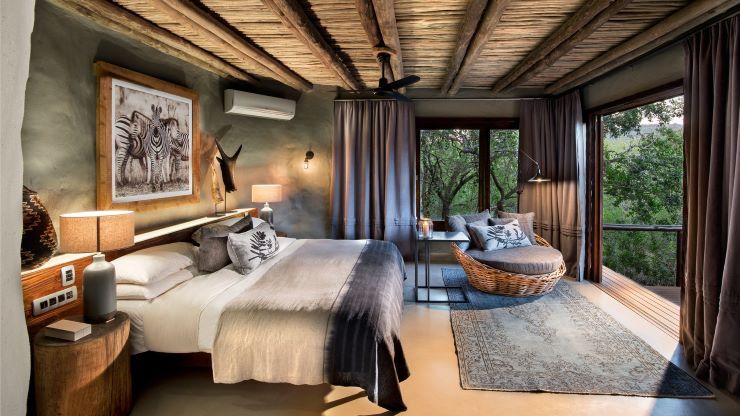You want to travel to Africa while maintaining the highest standards of ethics and sustainability? We’ve compiled a list of 8 eco-friendly spots in Africa for you to visit.
- Bisate Lodge, Rwanda
- Singita Faru Faru Lodge, Tanzania
- Serengeti Safari Camp, Tanzania
- Desert Rhino Camp, Namibia
- Grootbos Private Nature Reserve, South Africa
- Kasbah Bab Ourika, Morocco
- Hoanib Valley Camp, Namibia
- Beyond Phinda Rock Lodge, South Africa
1. Bisate Lodge, Rwanda
Volcanoes National Park Ruhengeri, Rwanda

What enables the sustainability of Bisate Lodge Rwanda?
- Mountain Gorilla Conservation: Bisate intends to develop into a Center of Excellence for research on great apes, with a particular emphasis on mountain gorillas, and eventually expand a regional, sustainable economy based on conservation. It is thought that this goal will make it easier for Rwanda’s Critically Endangered Mountain gorilla population to grow.
- Community Partnership: As a result of our partnership with the neighborhood’s residents, which included buying the Bisate site from 103 neighborhood residents and investing $500 000 in the neighborhood, over 200 locals were employed during the building of the property, and 24 more are now employed there permanently.
- Habitat Restoration: Reforestation of 43 hectares (103 acres) of Bisate land in a gradual method is one of our most exciting efforts. This area is intended to replicate the natural vegetation zones of the volcanoes. A bamboo forest will be present at the lower level, and Hagenia and Dombea trees, among others, will help to recreate the local rainforest higher up. Birds and other animals will then naturally recolonize the newly forested area.
- Every guest a philanthropist: On Bisate’s property, we have so far planted more than 20,000 native trees. As part of our ongoing reforestation program, we invite visitors to spend some time in the tree nursery and plant a tree while they are here, directly aiding in the process of restoring the area.
Also read: 8 Oldest Hotels in Africa
2. Singita Faru Faru Lodge, Tanzania
Grumeti Reserves Serengeti National Park TZ, 31623, Tanzania

In addition to replacing the lodge’s old diesel generators with a brand-new solar PV plant, the renovation’s cutting-edge sustainable design also took care to make sure that its supply chain was sustainable.
Other noteworthy advantages include that 90% of the energy used at the resort now comes from renewable sources, and Faru Faru reduced the number of generators from five to just one.
Additionally, this generator is currently only used for two hours each day. The environmental burden of bringing fuel to the lodge is significantly reduced in addition to assuring less generator noise pollution.
3. Serengeti Safari Camp, Tanzania
What makes Serengeti Safari Camp sustainable?
Beyond grand excursions, the outdoors is what drives our way of life. In order for us to meaningfully contribute to the conservation of our wildlife, we believe that we must attend to the needs of our people, always making sure that it is they who gain from maintaining the safety of natural places.
4. Desert Rhino Camp, Namibia

This camp uses a hybrid power system that combines a diesel generator to charge a bank of batteries, which then uses an inverter to provide electricity to a portion of the camp.
Each guest tent is equipped with a small solar panel, an inverter, and a solar-powered geyser to heat the water inside. Water-efficient equipment has been used in the camp for both visitors and workers in an effort to conserve water.
We utilize energy-efficient lights and appliances to lower our power usage. Reverse osmosis filtration is carried out on-site to give visitors with high-quality drinking water in an effort to lessen our reliance on bottled water.
Desert Rhino Camp, like all Wilderness Camps, is run and monitored in accordance with very high internal environmental standards.
5. Grootbos Private Nature Reserve, South Africa

Therefore, in Grootbos, our conservation projects are concentrated on giving locals sustainable natural-based livelihoods as well as on safeguarding and restoring our special natural heritage.
Key conservation and development programs are implemented through the foundation using funds raised by the Grootbos ecotourism business as well as donations from visitors and other donors.
This way, every visitor to Grootbos directly contributes to the preservation of biodiversity and the improvement of social conditions in the Walker Bay area.
6. Kasbah Bab Ourika, Morocco

The walls, which are made of rammed earth, also known as pisé, are thick and maintain a constant temperature throughout the year. A biodigester converts waste materials into power, gas, and compost for the garden. Solar panels are utilized for hot water and heating. Recycled water is used in the gardens.
7. Hoanib Valley Camp, Namibia
Skeleton Coast, Namibia

The walls are sturdy and maintain a constant temperature throughout the seasons since they are made of rammed earth, commonly known as pisé.
Recycled water is used in the gardens, solar panels are used for heating and hot water, and a biodigester converts waste into power, gas, and compost for the garden.
8. Beyond Phinda Rock Lodge, South Africa

The impact vision for Beyond’s care of the land, wildlife, and people was developed and refined in Phinda. This area saw the reclamation of 28 622 hectares of agricultural land for wildlife, including 790 hectares of an ancient sand woodland that is highly endangered.
With more than 30 years of groundbreaking wildlife triumphs behind us, cheetah, rhino, and pangolin are actively protected.
The reserve, together with Africa Foundation, works closely with nearby communities, hiring locally, and making investments in the welfare and education of the neighborhood. Eliminating throwaway bottles and emphasizing energy-saving activities are only two examples of the sustainability actions that are prioritized on a daily basis.
